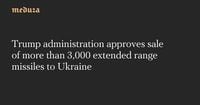In a move that could reshape the military calculus of the ongoing conflict in Eastern Europe, the Trump administration has approved a landmark arms deal with Ukraine, providing the embattled nation with thousands of extended-range missiles and related equipment. The $825 million agreement, announced by the U.S. State Department on August 28 and 29, 2025, marks the first major sale of a new weapon system to Ukraine under President Donald Trump, signaling a potential shift in U.S. support for Kyiv as Russia intensifies its attacks.
According to the Pentagon’s Defense Security Cooperation Agency, Ukraine will receive up to 3,350 Extended Range Attack Munition (ERAM) missiles, each capable of striking targets at distances between 240 and 450 kilometers (about 150 to 280 miles), along with 3,350 GPS units, missile containers, and a suite of components, spare parts, training, and technical support. The funding for this package is being drawn from a coalition of NATO allies—Denmark, the Netherlands, and Norway—as well as U.S. foreign military financing, as reported by The Wall Street Journal and CNN.
"This proposed sale will improve Ukraine’s capability to meet current and future threats by further equipping it to conduct self-defense and regional security missions," the Defense Security Cooperation Agency stated, underscoring the deal’s intended impact. The State Department added that the sale would "support the foreign policy and national security objectives of the United States by improving the security of a partner country that is a force for political stability and economic progress in Europe."
The main contractors for the deal are California-based Zone 5 Technologies and Virginia-based CoAspire, according to Nexstar Media. The Pentagon has emphasized that the sale "will not alter the basic military balance in the region" and will not affect U.S. combat readiness.
The timing of the announcement is significant. The deal comes as Russia has ramped up its ground offensives and missile attacks on Ukrainian cities, even as U.S. efforts to broker a peace agreement appear stalled. President Trump has made high-profile attempts to facilitate a ceasefire, meeting Russian President Vladimir Putin in Alaska earlier in August and hosting Ukrainian President Volodymyr Zelensky and European leaders at the White House just days later. Despite these efforts, neither Moscow nor Kyiv has shown much willingness to make the necessary concessions for a negotiated settlement, with Russian officials rejecting a proposed bilateral meeting and Ukraine resisting territorial swaps.
U.S. NATO Ambassador Matt Whitaker, speaking to Fox News on August 29, described the sale as a way to give Ukraine "deeper strike capabilities." He explained, "They've already taken about 20% of Russia's oil refining capacity last month," referencing Kyiv’s escalated long-range drone strikes on Russian oil infrastructure—a crucial source of revenue for Moscow’s war effort. Until recently, Ukraine relied mainly on domestically produced drones for these operations, as Western-provided long-range missiles were in limited supply and subject to strict usage restrictions.
Only in late 2024 did then-President Joe Biden ease some of these restrictions, allowing Ukraine to use ATACMS missiles against military targets inside Russia—a move that Trump, at the time, criticized as too little, too late. However, Trump’s own position has evolved. In a July 2025 call with Zelensky, he reportedly suggested that Ukrainian forces could strike Moscow, though the White House later claimed his comments were taken out of context, according to The Financial Times. As of now, the Trump administration has made no official announcement regarding whether Ukraine will be permitted to use the new ERAM missiles against targets on Russian territory, leaving a key question unanswered.
Whitaker also highlighted the scale of U.S. military support, stating, "The U.S. is selling about a $1 billion a month through our NATO allies that are being provided to Ukraine," likely referencing the NATO-led Prioritized Ukraine Requirements List (PURL) initiative. This figure includes the recent $329.1 million in military sales for components related to the upkeep of Ukraine’s Patriot air defense systems and Starlink communication terminals, as confirmed by the U.S. State Department.
Amid these military developments, the U.S. has also imposed new sanctions on India aimed at curbing its imports of Russian oil. Whitaker expressed optimism that these measures would pressure New Delhi to reduce purchases from Moscow. Nevertheless, Reuters reported that India’s Russian oil imports are expected to increase by 10 to 20 percent in September, suggesting that the sanctions may not have the immediate effect Washington hopes for.
The ERAM missile sale is notable not just for its scale, but also for its novelty. As CNN observed, this is the first major deal for a new type of weapon approved by the Trump administration for Ukraine; previously, only equipment already supplied by the U.S. or its allies was authorized for sale. The delivery of these missiles could begin as early as 2025, though it remains unclear whether the U.S. will impose restrictions on how they are used—a point of keen interest both in Kyiv and in Western capitals.
The broader context is one of persistent violence and diplomatic deadlock. In July 2025, the U.S. announced two other weapons sales to Ukraine, worth $322 million and $330 million, aimed at bolstering air defense and maintaining artillery vehicles. Despite these efforts and repeated calls for European allies to shoulder more of the financial burden for Kyiv’s defense, the war grinds on. Trump has pledged to broker a swift peace deal, but after meetings with both Putin and Zelensky in August, there is little sign of a breakthrough.
While the Pentagon maintains that the ERAM deal "will not have adverse impact on U.S. military readiness," and that it is designed to support regional stability, the reality on the ground remains grim. Russia continues to escalate attacks, and Ukraine, now armed with longer-range munitions, faces critical decisions about how—and where—to deploy its new capabilities.
As the world watches, the approved arms sale stands as both a symbol of deepening Western support for Ukraine and a stark reminder of the conflict’s unresolved dangers. Whether these new weapons will tip the balance or simply prolong the fighting remains to be seen. For now, the people of Ukraine continue to brace for what comes next.

